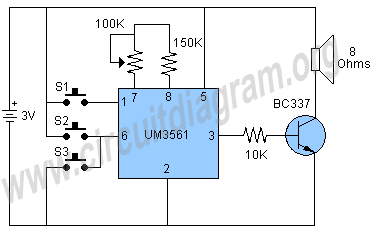
Siren sound generator circuit with UM3561

The circuit under discussion is a four-siren sound generator utilizing the UM3561 integrated circuit (IC), which is a low-power CMOS device. Four distinct sounds can be generated by activating switches S1, S2, and S3. This circuit is versatile and suitable for various sound generation applications, such as tone generation, alarm systems, or siren circuits. The design is straightforward, comprising only seven components and powered by a 3V battery, making it ideal for low-voltage applications. The IC can directly drive a piezo speaker without requiring an amplification stage. For driving an 8-ohm speaker, a single transistor amplifier is employed, as depicted in figure 1. If additional amplification is necessary, the circuit in figure 2 utilizes an LM386 amplifier for enhanced sound output. This circuit also includes a 3V zener diode for voltage regulation, which reduces a 9V supply to 3V, as the UM3561 IC cannot operate above 3V DC.
The four-siren sound generator circuit is designed for simplicity and efficiency, leveraging the capabilities of the UM3561 IC, which is known for its low power consumption and ease of integration into various applications. The circuit's architecture allows for the production of different sound patterns based on the switch inputs, enabling users to customize the auditory output for specific needs.
The use of a 3V battery ensures that the circuit remains within the operational limits of the UM3561 IC, which is crucial for maintaining performance and reliability. The direct drive capability for a piezo speaker eliminates the need for additional components, streamlining the design and reducing potential points of failure.
In applications where a higher output is required, the inclusion of a transistor amplifier for an 8-ohm speaker provides a straightforward solution for enhancing sound levels without significantly complicating the circuit. The option to use an LM386 amplifier in figure 2 further expands the circuit's capabilities, allowing for substantial increases in volume while maintaining sound quality.
The addition of a zener diode for voltage regulation is an important feature, ensuring that the circuit operates safely and effectively under varying supply conditions. This protective measure guarantees that the UM3561 IC remains within its specified voltage range, thereby preventing damage and ensuring longevity.
Overall, this four-siren sound generator circuit exemplifies a practical and efficient design suitable for a variety of sound generation applications, combining low power consumption, ease of use, and adaptability to different output requirements.The circuit we are going to discuss here is a four siren sound generator using UM3561 IC which is a low power CMOS IC. The four different sounds can be produced by pressing the switches S1, S2 and S3. The circuit can be used for any type of sound generation requirements, for example you can use it as tone generator, alarm circuit, siren circuit e
tc. The circuit is quite simple using only seven components and a 3V battery due to which it is ideal for many low voltage applications. The IC can drive a pheizo directly without using any amplication stage. For driving a 8 ohm speaker we have used a single transistor amplifier in figure 1. If more amplification required then use the circuit mentioned in figure 2 which is using a lm386 amplifier for further amplification of sound.
The circuit mentioned in figure 2 is using a 3V zener diode for voltage regulation which will step down 9V to 3V because UM3561 IC can not be opreated above 3V DC. 🔗 External reference
The four-siren sound generator circuit is designed for simplicity and efficiency, leveraging the capabilities of the UM3561 IC, which is known for its low power consumption and ease of integration into various applications. The circuit's architecture allows for the production of different sound patterns based on the switch inputs, enabling users to customize the auditory output for specific needs.
The use of a 3V battery ensures that the circuit remains within the operational limits of the UM3561 IC, which is crucial for maintaining performance and reliability. The direct drive capability for a piezo speaker eliminates the need for additional components, streamlining the design and reducing potential points of failure.
In applications where a higher output is required, the inclusion of a transistor amplifier for an 8-ohm speaker provides a straightforward solution for enhancing sound levels without significantly complicating the circuit. The option to use an LM386 amplifier in figure 2 further expands the circuit's capabilities, allowing for substantial increases in volume while maintaining sound quality.
The addition of a zener diode for voltage regulation is an important feature, ensuring that the circuit operates safely and effectively under varying supply conditions. This protective measure guarantees that the UM3561 IC remains within its specified voltage range, thereby preventing damage and ensuring longevity.
Overall, this four-siren sound generator circuit exemplifies a practical and efficient design suitable for a variety of sound generation applications, combining low power consumption, ease of use, and adaptability to different output requirements.The circuit we are going to discuss here is a four siren sound generator using UM3561 IC which is a low power CMOS IC. The four different sounds can be produced by pressing the switches S1, S2 and S3. The circuit can be used for any type of sound generation requirements, for example you can use it as tone generator, alarm circuit, siren circuit e
tc. The circuit is quite simple using only seven components and a 3V battery due to which it is ideal for many low voltage applications. The IC can drive a pheizo directly without using any amplication stage. For driving a 8 ohm speaker we have used a single transistor amplifier in figure 1. If more amplification required then use the circuit mentioned in figure 2 which is using a lm386 amplifier for further amplification of sound.
The circuit mentioned in figure 2 is using a 3V zener diode for voltage regulation which will step down 9V to 3V because UM3561 IC can not be opreated above 3V DC. 🔗 External reference





